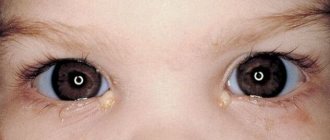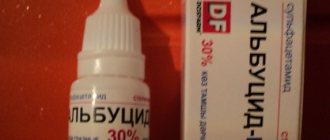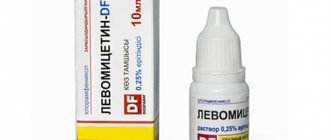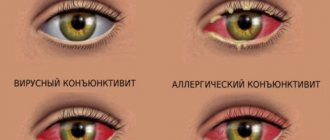After respiratory diseases, sore throat or a severe cold, the immune system weakens and the body’s defense against viruses decreases. During this period, the risk of ophthalmic inflammation, including viral conjunctivitis, increases. Viral conjunctivitis causes severe discomfort and is dangerous to health, so it is important to know its symptoms and implement prevention.
Main characteristics of viral conjunctivitis
Viral conjunctivitis is a fairly common disease. Often it occurs episodically. Conjunctivitis indicates the onset of inflammation. The process affects the mucous membrane of the eye and the inside of the eyelid.
Conjunctivitis can be a symptom of another disease. Eye inflammation is often observed with colds and systemic viral infections. Most often, conjunctivitis accompanies measles, chickenpox, rubella and mumps (mumps).
Isolated inflammation, which does not provoke systemic disorders, is usually caused by adenoviruses. Less commonly, the cause is the activity of enteroviruses. The incubation period of the disease is 5-12 days. After this, the eye turns red, discharge occurs, and irritation of the mucous membrane is felt. Inflammation quickly spreads to the second eye.
In severe cases, patients report a sensation of foreign particles in the eye. Photophobia often develops. Vision loses clarity due to the formation of fibrin pseudomembranes and inflammatory cells. After severe conjunctivitis, foci of corneal opacification can be noticed during examination for the next 2 years.
In children, viral conjunctivitis develops due to poor hygiene in situations where the child picks up dirty objects and immediately rubs his eyes. It is noteworthy that in children, viral conjunctivitis is milder. Therefore, severe cases of inflammation in children are much less common, and mild conjunctivitis often does not even require treatment.
Indications for use
The drug Albucid is prescribed after diagnosing such pathological processes and diseases as:
- conjunctivitis of various origins;
- barley;
- blepharitis;
- dacryocystitis;
- keratitis;
- purulent formations;
- redness of the whites of the eyes.
The medicine is recommended for use when foreign bodies get into the eyes, after surgical interventions.
Indicated for the prevention of blenorrhea in newborns and the prevention of infectious ophthalmological diseases in children and adults .
Types of viral conjunctivitis
The inflammation affects both eyes, although usually only one is affected at first. A distinctive feature of viral conjunctivitis is its frequency during the months of the spread of adenoviral and enteroviral diseases.
Herpetic conjunctivitis
Damage to the mucous membranes and conjunctivitis develop when the herpes virus actively multiplies in a weakened body. Typically, inflammation appears due to the herpes virus or herpes zoster; less commonly, the Epstein-Barr virus and cytomegalovirus are the cause. The cause of herpetic conjunctivitis is infection with the herpes virus, usually at an early age.
A characteristic sign of such inflammation is severe damage to the edges of the eyelid, skin and cornea. The course can be vesicular-ulcerative or follicular, but most often the inflammation is superficial.
Herpetic conjunctivitis begins in one eye. At first, the inflammation is sluggish and slow, and the symptoms are usually erased. Conjunctivitis can be combined with rashes on the skin of the eyelids and around the eyes. The catarrhal form is characterized by the presence of slight mucous discharge. If a bacterial infection begins in parallel, purulent discharge appears.
Herpetic conjunctivitis requires specific treatment, which cannot be delayed. Self-medication increases the chances of worsening inflammation. Often after herpetic conjunctivitis, dendritic keratitis develops with damage to the cornea.
Adenoviral conjunctivitis
Adenoviral conjunctivitis usually affects the eyes and nasopharynx. The patient has catarrh of the upper respiratory tract, high fever, and swollen lymph nodes. There is marked redness of the eyes and eyelids, as well as significant swelling. Adenoviral conjunctivitis rarely affects the cornea.
Viral conjunctivitis can be diagnosed based on laboratory, cytological, serological and virological studies. Such inflammation is usually diagnosed in children. Adenoviruses are transmitted by airborne droplets, so this conjunctivitis is contagious. Sometimes infection occurs through contact.
How is viral conjunctivitis transmitted?
According to the nature of the pathogen, inflammation is divided into isolated and concomitant. Isolated conjunctivitis is caused by the activity of a specific virus. This could be herpes, enterovirus, adenovirus, Coxsackie virus and others. Concomitant inflammation develops against the background of another viral infection (measles, chickenpox, rubella, mumps, influenza).
In 70% of cases, patients with viral conjunctivitis require hospitalization. This is due to the fact that the disease is easily transmitted to others: viruses are transmitted less frequently by airborne droplets than by contact, but herpetic conjunctivitis spreads primarily through the air.
Clinical picture of viral conjunctivitis
At the initial stage of development, any type of inflammation is manifested by redness of the mucous membrane, swelling of the eyelids, and lacrimation. Conjunctivitis is characterized by first damage to one eye, then rapid spread of the process to the second. Sometimes, with viral conjunctivitis, severe headaches occur, and patients begin to experience fatigue and weakness. There are sleep disturbances and enlarged lymph nodes.
Symptoms of different forms of inflammation:
- With the catarrhal form of conjunctivitis, profuse lacrimation is noted. Minor purulent discharge may appear. Viral conjunctivitis lasts an average of a week.
- Follicular inflammation is characterized by the appearance of follicles on the edges of the eyelid.
- The intensification of conjunctivitis and the transition to a vesicular-ulcerative form will be indicated by the appearance of ulcers and erosions. This form is often accompanied by lacrimation, photophobia, discomfort and even pain.
- The membranous form of conjunctivitis causes the appearance of a thin grayish film that can be easily removed with a cotton swab. In some cases, the film cannot be removed. This inflammation is characterized by the appearance of hemorrhages and small compactions.
After a week, patients begin to feel relief, but the symptoms of inflammation intensify again. Viral conjunctivitis can last 2 months, but with timely treatment it can be cured much faster.
Treatment of viral conjunctivitis
The first step for conjunctivitis is to prescribe tear substitutes for normal hydration of the mucous membrane and warm compresses. For severe inflammation, your ophthalmologist may prescribe corticosteroid eye drops. Hormones help balance secretions, but they must be used carefully and in short courses. Ointments and drops with antiviral effects help cure viral conjunctivitis.
During pregnancy, you should carefully select medications for the treatment of viral conjunctivitis. Inflammation does not harm the fetus, but some medications can be dangerous (chloramphenicol). For conjunctivitis in pregnant and lactating women, Actipol or Poludan are prescribed.
For any type of conjunctivitis, Albucid drops with sodium sulfacyl will be effective. The drug is instilled after washing, then drops with interferon are used and after 30 minutes the ointment is applied.
Viral conjunctivitis is treated with antiviral drops
- Oftalmoferon. The drug has antiviral, anti-inflammatory and immunomodulatory effects. This effect is caused by the presence of human interferon in the composition of Ophthalmoferon. The product must be instilled 6-8 times a day during an acute process and 2-3 times during recovery.
- Poludan. These antiviral drops are based on biosynthetic endogenous interferons, cytokines and interferons in the tear fluid. Poludan is prescribed for adenoviral and herpetic conjunctivitis. The product is instilled 6-8 times a day and 3-4 times as recovery progresses. The course of treatment is from 7 to 10 days.
- Aktipol. The drug is an inducer of endogenous interferon, which has antiviral, regenerative and antioxidant effects on tissues and mucous membranes. Actipol is instilled 3-8 times a day (2 drops). The course of treatment for conjunctivitis is 10 days.
In addition to drops, the ophthalmologist may prescribe additional antiviral ointments. Some drugs are approved for children, but before use it is advisable to rinse the eyes with a fresh infusion of chamomile, sage or weak tea. You should first check for allergies to these drugs.
What ointments can be used for viral conjunctivitis
- Florenal. An antiviral agent that effectively fights the herpes virus, adenoviruses, varicella zoster virus (herpes zoster and chickenpox). The ointment should be used 2-3 times a day. Florenal is placed behind the lower eyelid. The course of treatment for conjunctivitis is 10-45 days.
- Tebrofenovaya. This is a universal remedy that is prescribed for any viral lesions of the visual system. The ointment is most effective for adenoviral conjunctivitis. It is necessary to use it 3-4 times a day.
- Bonafton. The drug is active against adenoviruses and herpes viruses. Adults should use the ointment 3-4 times a day, 0.1 g for 15-20 days. Children with conjunctivitis are prescribed 1-4 doses of 0.025 g for two weeks.
Sometimes, for viral conjunctivitis, antibacterial ointments with antibiotics are prescribed. If an infection is associated with inflammation, it is necessary to add erythromycin or tetracycline ointments to the therapy. Adenoviral conjunctivitis with proper treatment disappears in 2-3 weeks.
Therapy for herpetic conjunctivitis includes antiviral, anti-inflammatory, interferon drops and ointments. If the skin of the eyelids is severely damaged, it should be carefully treated with brilliant green.
Therapy for herpetic inflammation
- Applying antiherpetic ointment (Zovirax, Acyclovir, Virolex, Bonafton, Florenal, tebrofen ointment).
- If the skin around the eyes is affected, oral antiherpetic drugs (Acyclovir, Valtrex) are prescribed.
- Additionally, immunomodulators (Cycloferon or Polyoxidonium) are required.
- To prevent bacterial infection, antibiotic eye ointments (erythromycin, tetracycline) or drops (Tobrex) are prescribed.
If a bacterial infection has begun, you need to add antimicrobial drugs to the antiviral drugs. This may be Levomycetin, but it cannot be used for fungal skin infections, psoriasis, eczema, as well as for pregnant and lactating women. Furacilin also has an antimicrobial effect, but also accelerates tissue regeneration. For conjunctivitis, it is prescribed for washing or instillation. A solution can be prepared by mixing furatsilin with sodium chloride (1:5000).
Features of use
The drug has few contraindications, and can be used already in the first year of a child’s life.
Attention, Expectant Mothers! It is necessary to use the product during pregnancy and under the age of 8 years in 20% form. Adults use 30% composition.
To achieve quick results, strictly follow the instructions and algorithm for using drops:
- Before use, wash the eyes. Children can cleanse them with furatsilin or chamomile decoction. The same remedies are used in adults; in addition, tea leaves are used.
- In the first 1-2 days, when conjunctivitis is in the acute stage, Albucid is dripped 6 times a day, 2-3 drops, for adults and children.
- When the symptoms begin to subside, the dosage is reduced. Ideally, a doctor should monitor the treatment process. Severe forms take longer to treat than simple ones.
- Before instillation, the medicine is slightly warmed up by holding it in your hand for 10-15 seconds.
- After thoroughly washing your hands and treating them with an antiseptic , pull back the lower eyelid and bury it in the area closest to the bridge of the nose.
- It is better to look up so that the drug does not get directly on the cornea.
- Close your eyes, press your fingers on the inner corners - this will prevent the product from flowing out from under the eyelids and prevent it from getting into the maxillary sinuses.
For you: What vitamins can boost immunity in adults and children?
If the disease affects one eye, the drug is used on both. This will avoid secondary infection of the second organ of vision. If the product leaks out a little, wipe it with a cotton pad or sterile cloth, but not with clean fingers.
How much Albucid to drip for conjunctivitis is determined by the doctor. The classic scheme of use allows treatment for 7-10 days in a row . Only a doctor has the right to extend therapy.
If the body responds normally to treatment and the healing process begins, then by 3-4 days the symptoms will greatly weaken. If the complete clinical picture is preserved by the end of the first week of using the drops, you can think about their therapeutic ineffectiveness.
Use in children
Immediately after birth, the maternity hospital staff instills 2 drops of the solution into the child, and after 2 hours the procedure is repeated. This is necessary to prevent blenorrhea. Children over 8 years of age are prescribed the classic dosage, but with a 20% solution.
How to treat acute conjunctivitis
With acute inflammation, a lot of purulent discharge appears that needs to be removed, otherwise the risk of developing a microbial environment increases. For cleaning, use boron solution or antibacterial drops.
Acute forms of conjunctivitis are treated with viruscidal drugs with oxoline, tebrofen or florenal. These can be ointments or solutions. The use of Albucid and tetracycline ointment for acute conjunctivitis is ineffective, but these drugs are suitable for preventing relapse.
Indications
Due to the bacteriostatic effect, these drops are prescribed not only for conjunctivitis, but also for the following ophthalmological pathologies:
- Blepharitis.
- Keratitis.
- Ulcerative lesion of the cornea, accompanied by the discharge of pus.
- Barley.
- Dacryocystitis.
Sometimes the drug is used to treat a runny nose, accompanied by thick, purulent yellow-green discharge, which also indicates the presence of a bacterial infection.
Alternative treatment for viral conjunctivitis
Traditional medicine recipes can only be used in complex therapy of viral conjunctivitis. You can use any means for eye inflammation only with the permission of an ophthalmologist, otherwise you can aggravate the condition and provoke serious complications.
The most effective method of treating eye inflammation is lotions. It is allowed to apply gauze or cotton cloth soaked in dill juice. 15 minutes at a time is enough.
For inflammation, you can use rosehip infusion. To prepare it, you need to infuse two tablespoons of berries in a glass of boiling water, filter and apply to your eyes for 15 minutes.
Honey is sometimes used to prepare lotions. You need to add a teaspoon to a glass of water and boil for 2 minutes. After the solution has cooled, a suitable cloth is moistened in it and applied to the eyes for 15 minutes twice a day. It should be remembered that honey often causes a severe allergic reaction.
Herbs can help fight inflammation. To prepare a solution for lotions, you need to boil two tablespoons of cornflower flowers in 0.5 liters of water (10 minutes). Leave to infuse for 30 minutes, strain and use similarly to other lotions.
Chamomile and sage are suitable for washing with viral conjunctivitis. You can make compresses against inflammation using aloe juice: mix the juice and cooled boiled water (1:1). Compresses can be done 2-3 times a day and kept for 5-10 minutes.
Side effects and overdose
In rare cases, after the first dose of Albucid drops, itching, conjunctival hyperemia, and lacrimation may occur. Local reactions are short-lived. If side effects are pronounced, a reduction in the dosage of the drug or its discontinuation is required.
When the drug is used correctly in therapeutic doses, no overdose symptoms are observed.
Special instructions and precautions
After opening the bottle, the drug should be stored in a cool place at a temperature not exceeding 15 degrees for no more than 28 days.
Albucid solution is not compatible with any drugs that contain silver salts.
It is possible to develop a cross-allergic reaction in the presence of hypersensitivity to glibenclamide, hypothiazide and other diuretics.
When wearing contact lenses, contact with Albucid should be avoided, as this may cause clouding of the lenses. The average price in Russian pharmacy chains for Albucid eye drops is 30 rubles, the price may vary depending on the region.
Complications of viral conjunctivitis
The most common complication of conjunctivitis is the transition of the disease to a chronic form. This occurs with insufficient or incorrect treatment. Non-compliance with doctor’s recommendations, violation of medication regimen, and termination of therapy before complete recovery can contribute to the chronicity of inflammation.
Also often with conjunctivitis, keratitis develops, that is, inflammation of the cornea. This condition can cause blindness, so treatment of the inflammation must be taken seriously. When deep tissues are damaged, dangerous phlegmons and abscesses form.
Properties and effects of the drug
Albucid is sold in pharmacies in the form of a clear solution intended for eye drops for bacterial infections. The active substance on which the medicine is made is sodium sulfacetamide. This component has bacteriostatic properties and is active against the following pathogenic organisms:
- Chlamydia.
- Staphylococci.
- Streptococci.
- Escherichia coli, and others.
As auxiliary ingredients, the medication contains purified water, hydrochloric acid and sodium thiosulfate.
The drug is available in the form of 10%, 20% or 30% solutions of sodium sulfacetamide. The mechanism of action of this substance is the inhibition of dihydropteroate synthetase and disruption of the production of tetrahydrofolic acid, without which the synthesis of pyrimidines and purines is impossible. That is, after the medicinal solution penetrates the eye tissue, pathogens stop multiplying due to the lack of necessary nutrients, and their death occurs.
Prevention of eye inflammation
The main measure to prevent viral conjunctivitis is to avoid contact with sick people and potentially contaminated objects (for example, in a hospital). During the period of active spread of viral infections, crowds of people should be avoided and the immune system should be strengthened in every possible way.
To protect yourself from viral conjunctivitis, you must follow the rules of personal hygiene. You should wash your hands regularly using disinfectants and special wipes. You need to dry your hands and face with a personal towel.
A healthy lifestyle and taking vitamins will help strengthen the body and counteract viruses. We must not forget about preventive examinations, because an ophthalmologist can notice early symptoms of inflammation. By taking precautions and leading a healthy lifestyle, you can protect yourself from viral conjunctivitis and protect your loved ones.
Sources used:
- Current issues in ophthalmology / ed. T.V. Shlopak, Ustimenko Ustimenko I L.L. etc. I. - M.: Kyiv, 1986.
- Eye microsurgery. Guide for doctors / A.I. Gorban, O.A. Jaliashvili. - M.: Medicine, 1982.
- Revelations of a surgeon. How I did the world's first eye transplant / E. Muldashev. - Moscow: Lights, 2010.
- Wikipedia article











